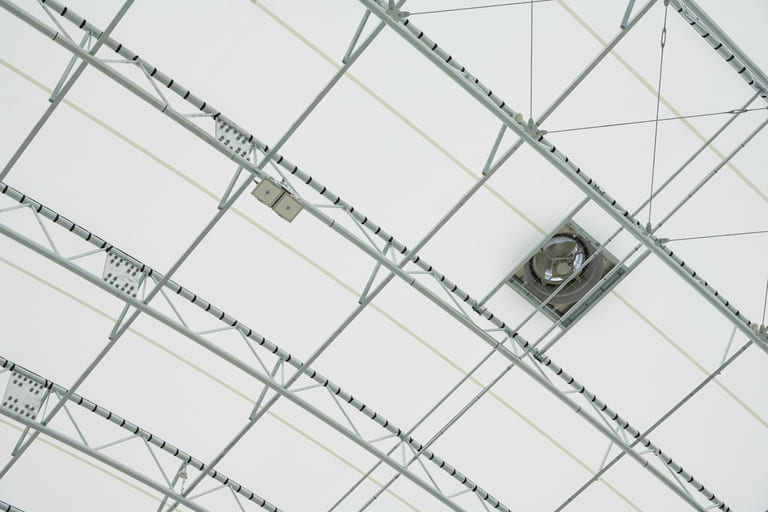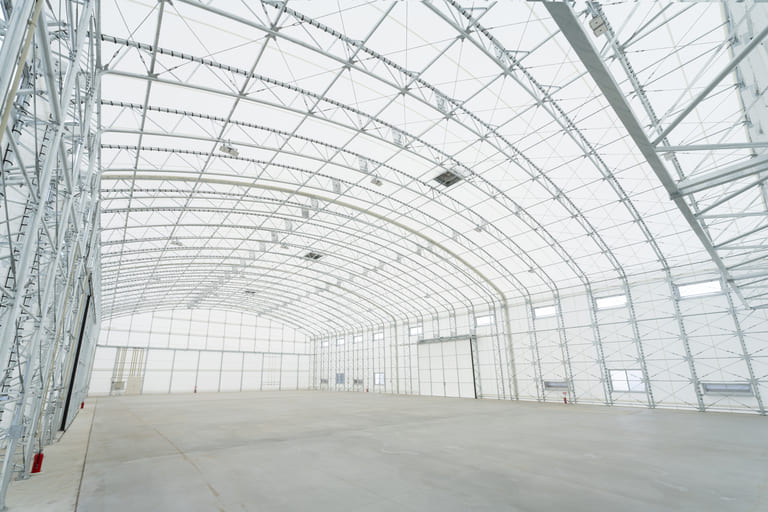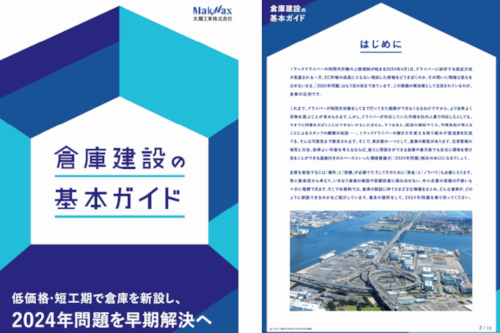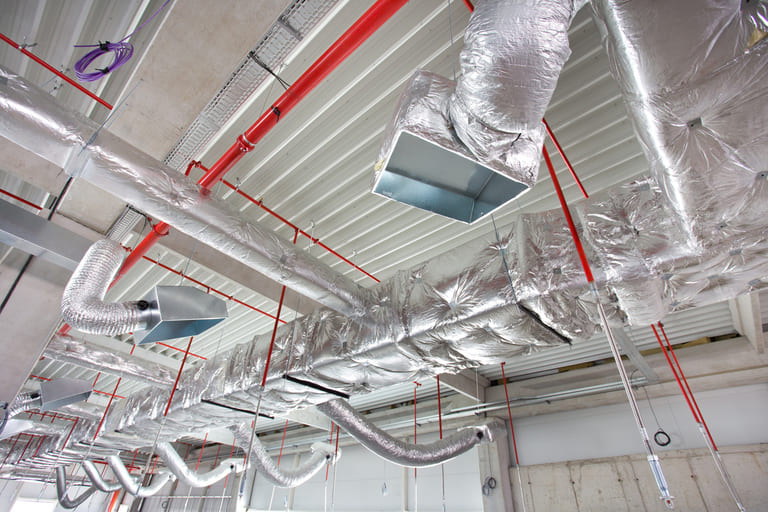

Taiyo Kogyo Column
What makes tent warehouses earthquake resistant? Explanation of service life, longevity, and even important maintenance.
2025.05.01

While tent warehouses are highly flexible, many are concerned about their earthquake resistance.
In reality, however, it has higher earthquake resistance than it appears, and its performance has been confirmed in a survey conducted by the “Japan Membrane Structure Association.
This is because membrane materials (tent fabrics) and specifications are optimized under professional architectural plans.
This article details the reasons for the high earthquake resistance of tent warehouses, as well as their service life, longevity, and important maintenance for long and safe use.
>> Click here to visit our website specializing in “Tent Warehouses”.
What is the earthquake resistance of tent warehouses?

Tent warehouses have lighter structures and are more earthquake resistant than typical steel buildings.
Since the energy of an earthquake on a building is proportional to its weight, lightweight tent warehouses are less susceptible to shaking.
In fact, the weight of a tent warehouse is about half that of a typical warehouse, and this lightness allows it to follow the shaking during an earthquake, creating characteristics that limit damage.
Furthermore, tent warehouses are constructed in accordance with the technical standards notified by the Ministry of Land, Infrastructure, Transport and Tourism, thus ensuring safety.
Its structure is designed to be highly flexible and easily adaptable to deformation caused by horizontal and vertical shaking.
Another major advantage is that the simple structure of the tent fabric stretched over the framework makes it easy to reinforce and dismantle.
These characteristics make tent warehouses earthquake-resistant and safe.
Survey by Japan Membrane Structures Association
According to a survey conducted by the Japan Membrane Structures Association, membrane structures used in tent warehouses are highly earthquake resistant.
The study revealed that the vibration of the membrane stretched over the framework is extremely small, indicating safety with low risk of rupture of the membrane during an earthquake.
As a result, membrane structures have been recognized for their superior earthquake resistance and are attracting attention as an effective structure in the building field.
*Source: Earthquake response analysis for evaluating the seismic performance of framed membrane structures
Earthquake Protection for Tent Warehouses
Although tent warehouses are earthquake-resistant structures, this does not mean that they do not require earthquake protection at all.
In particular, it is recommended to choose a type with a solid framework to ensure safety.
This will increase its strength against shaking.
However, care should be taken to ensure that the service life of the tent warehouse is adequate. The tent fabric is expected to last approximately 10 to 15 years, while the lightweight steel portion of the framework is approximately 20 years, and its seismic resistance may deteriorate over time.
Therefore, it is important to maintain safety through regular inspections and appropriate maintenance.
Furthermore, selecting a reliable contractor and checking not only the construction but also the maintenance system will ensure more reliable earthquake countermeasures. Proper management will ensure the long-term safety of your tent warehouse and minimize the risks associated with earthquakes.
Features of Tent Warehouses Demonstrated During Earthquakes and Disasters
The major advantage of tent warehouses is their ability to respond quickly in the event of a disaster.
In the event of an earthquake or other disaster, reinforcement work, tent fabric replacement, and even dismantling if necessary, can be done with relative ease.
These characteristics allow for smooth post-disaster restoration activities and support business continuity.
This is why tent warehouses can be a viable option as part of a disaster preparedness plan.
Conditions for tent warehouses requiring seismic evaluation

Tent warehouses basically have an earthquake-resistant structure, but depending on the environment in which they are used and their purpose, they may be required to undergo an earthquake-resistance diagnosis to accurately determine their strength.
Seismic diagnosis is a process to check the earthquake resistance of a building in preparation for natural disasters. In addition to diagnosis subsidized by municipalities, it is also possible to receive free diagnosis by private companies.
Whether or not a tent warehouse needs to be inspected for earthquake resistance is mainly determined based on the purpose for which it is used and the damage it is expected to sustain in the event of an earthquake.
One of the possible damages is the risk of falling objects.
For example, if shelves are not secured, a large quake could cause stored goods to fall, causing damage or danger to workers.
Another consideration is the risk of equipment falling over. If unfastened equipment falls over, there is a risk of damage to merchandise, workers, and even machinery.
This risk is particularly high in tent warehouses used for temporary storage and shipping of goods. Therefore, it is important to get an accurate understanding of the current situation and take appropriate countermeasures by undergoing an earthquake resistance diagnosis.
It is recommended that measures be implemented based on the diagnosis to improve safety and reduce risk.
Service life and life expectancy of tent warehouses
The useful life of a tent warehouse is one of the most important factors to check before installing a tent warehouse.
Knowing in advance, especially the price and construction period, will help you select the appropriate warehouse.
In general, the service life of a tent warehouse is approximately 10-15 years for the tent fabric and approximately 20 years for the lightweight steel frame portion that serves as the framework.
However, this is difficult to determine in general, as it depends on the location, climate, and intended use.
The structure of a tent warehouse is characterized by a simple design in which sheets are stretched over a framework, and because of this, it has the advantage of being low-cost and quick to construct.
On the other hand, however, they are somewhat inferior in terms of service life when compared to system-built or prefabricated warehouses.
Nevertheless, by reusing the lightweight steel sections while periodically reupholstering the tent fabric, the overall useful life of the warehouse can be significantly extended.
By incorporating this method, the cost of future maintenance and replacement can be systematically estimated to ensure long-term operation.
Since the specific service life is largely influenced by the specifications of the warehouse and the environment in which it is installed, it is recommended that detailed discussions be held with the vendor prior to installation.
It is important to comprehensively consider factors such as price, construction period, durability, and convenience to select the best tent warehouse for your company’s requirements.
Useful life as a depreciable asset
According to the “Useful life (buildings/building fixtures)” set by the National Tax Administration Agency, the useful life of a tent warehouse made of metal with a skeletal material wall thickness of more than 4 mm and used for factories and warehouses is defined as 31 years.
*Source: Table of Useful Life of Major Depreciable Assets
This figure is only a standard for calculating depreciation and does not indicate the actual life in all cases.
The actual useful life will vary depending on the environment of the installation site, the structure of the building, and the conditions of use.
In the case of a typical tent warehouse, as mentioned above, the useful life of the tent fabric is approximately 10-15 years, while the lightweight steel frame portion used as the framework is estimated to last approximately 20 years.
Maintenance to maintain seismic resistance and serviceability
Regular inspection and maintenance are essential to the serviceability of tent warehouses.
Tent warehouses are composed of tent fabrics and steel frames, each of which deteriorates at different rates.
Tent fabrics are expected to last approximately 10 to 15 years, and deterioration is accelerated by exposure to direct sunlight, strong winds, and coastal environments, among other factors.
Ultraviolet rays and wind and rain also accelerate deterioration, so it is important to take measures appropriate to the environment.
On the other hand, although the light steel-frame portion has a relatively long life span of approximately 20 years, ongoing maintenance is required to maintain its durability.
A major advantage of tent warehouses is that their simple structure makes them easy to repair, replace, and dismantle. However, neglecting to do so, thinking “tent fabric lasts 10 years, so it’s safe,” can lead to unnoticed progression of deterioration and spread of damage.
For this reason, it is important to perform regular maintenance, taking into account environmental factors and usage conditions.
Maintenance includes a detailed check of the condition of the framework and tent fabric, and replacement of necessary parts and reupholstery.
If these appropriate measures are not neglected, it is possible to extend the overall useful life of the building while preventing seismic deterioration.
In addition, routine management and maintenance practices will help maintain the warehouse’s performance over time.
Thorough maintenance is important to achieve stable operations.
summary
Due to their lightweight structure and flexible design, tent warehouses have higher earthquake resistance than ordinary warehouses.
The light weight of the building makes it easy to absorb the energy of earthquakes, and the membrane structure stretched over the framework has characteristics that allow it to adapt easily to shaking.
Another major advantage is that it meets the technical standards of the Ministry of Land, Infrastructure, Transport and Tourism, ensuring safety.
However, the high earthquake resistance may not be enough to ensure safety if maintenance is neglected.
Although the tent fabric has a service life of approximately 10-15 years and the lightweight steel frame portion of the framework approximately 20 years, regular inspection and repair are essential.
In particular, in environments where the tent fabric is susceptible to ultraviolet rays and wind and rain, it is easy for the tent fabric to deteriorate, so it must be replaced as soon as possible.
Proper management and maintenance will help maintain the earthquake resistance and service life of tent warehouses, ensuring safe, long-term operation.
Furthermore, tent warehouses offer many other advantages besides their earthquake resistance.
Their simple, lightweight construction allows them to be built at low cost and in a short period of time. In addition, they are weather-resistant and so bright that lighting is unnecessary during the day, improving work efficiency.
Tent warehouses are increasingly being introduced, particularly by advanced manufacturers and the logistics industry. Consider tent warehousing as a means of achieving efficient warehouse operations.
If you are interested in tent warehouses, please contact Taiyo Kogyo Corporation, a manufacturer that has been in business for 100 years and has the largest market share in Japan. We will propose the best plan based on our technical capabilities and abundant experience backed up by our long track record.
Tent Warehouseへの
Contact us

What you need to know when building a warehouse
We've packed it all in.
Clues to solving the 2024 problem
<
・Don't know where to start in building a warehouse
・Want to build a warehouse economically
・Want to know which type of warehouse to build
・Anyway, want to learn the basics of warehouse construction
・Worried about the 2024 problem, but don't know what to do
Related Articles
- TOP>
- Taiyo Kogyo Column>
- What makes tent warehouses earthquake resistant? Explanation of service life, longevity, and even important maintenance.








